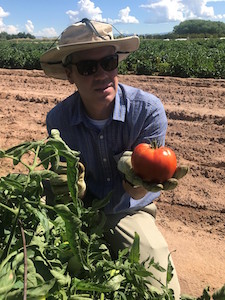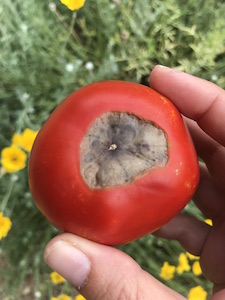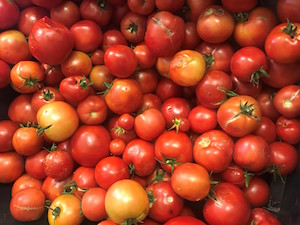Question: I’ve heard that homegrown tomatoes shouldn’t be stored in the refrigerator because they’ll lose their flavor. How does that work?
Sarah M., Las Cruces
Answer: The short answer is that volatile organic chemicals (aka volatiles) in tomato fruits are responsible for providing complex flavors—beyond plain old sweet and tangy tastes—and many of these volatiles are released when chilled to around 55°F or lower, thereby creating a noticeable loss in flavor. That’s why we’re told to keep tomatoes out in the open instead of in the crisper. The long answer winds up being a rich story of customer relations, plant breeding, plant physiology, chemistry, marketing, classical music, disappointment, and hope.
 Dr. Mark Marsalis, NMSU Extension Forages Specialist, helped harvest ‘Big Beef’ tomatoes at the NMSU Agricultural Science Center at Los Lunas in October 2018. Photo credit M. Thompson.Have you heard the saying “If you want a flavorful tomato, grow it yourself”? One reason for this is that the vast majority of grocers store their produce, including tomatoes, in coolers with temperatures that range between 45-55°F. Another reason is that most commercial growers produce fruit from hybridized tomato plants that, via breeding, have lost some of the genes that regulate flavor. Hybridized means they’re bred by cross-pollinating two different varieties and evaluating the offspring for desirable traits.
Dr. Mark Marsalis, NMSU Extension Forages Specialist, helped harvest ‘Big Beef’ tomatoes at the NMSU Agricultural Science Center at Los Lunas in October 2018. Photo credit M. Thompson.Have you heard the saying “If you want a flavorful tomato, grow it yourself”? One reason for this is that the vast majority of grocers store their produce, including tomatoes, in coolers with temperatures that range between 45-55°F. Another reason is that most commercial growers produce fruit from hybridized tomato plants that, via breeding, have lost some of the genes that regulate flavor. Hybridized means they’re bred by cross-pollinating two different varieties and evaluating the offspring for desirable traits.
We’ve all experienced the disappointment of cutting into a perfectly ripe-looking red tomato that’s pale white inside. Maybe we’ve all heard the explanation that over the past 50 or so years hybridized tomatoes have been bred more and more for qualities that ensure packability, shippability, longer shelf-life, uniformity, and surface-level ripeness, and not for flavor or nutrient content. In general, heirloom tomato plants, in comparison, are expected to produce fruits with more flavor, but at the price of reduced overall yields and higher disease vulnerability. More on this in a minute.
At the annual American Society for Horticultural Science conference two weeks ago, I attended a keynote address by Dr. Harry Klee of the University of Florida about biochemical genetics of tomatoes and ongoing efforts to identify genes that control flavor qualities with the end consumer in mind, without giving up traits that are important for growers. Klee explained that tomato breeders have been working to please their customers: the growers, not tomato-loving consumers. Because growers value traits like disease resistance, high yields, and storage qualities, the flavor traits have been inadvertently lost. In breeding programs, Dr. Klee warns: “If you don’t select for something, you’re selecting against it.” It may seem great to breed for increased drought resistance, but if you aren’t careful to also monitor and select for other important tomato traits, you might get a drought-resistant plant that tastes like wet sand. “Failure to monitor nutrient content leads to less-healthy foods,” Dr. Klee added, and the same is true for flavor.
But these trait changes don’t happen all at once. Dr. Klee made a helpful analogy for understanding how traits are lost inadvertently in breeding programs. Imagine you’re at a symphony when one of the violinists stops playing and quietly leaves. You probably wouldn’t notice just by listening. More musicians stop playing one by one, and slowly but surely you can hear the change. The end result is something that doesn’t resemble the original music at all.
 Classic symptom of blossom end rot on an otherwise perfect tomato. For help dealing with this common problem, visit https://nmsudesertblooms.blogspot.com and type “rot” into the search prompt. Photo credit M. Thompson.People think flavor is perceived in your mouth, but the mouth only tastes. The five basic tastes are sweetness, sourness, saltiness, bitterness, and umami. For the most part, sugar and salt contribute to a food’s sweetness or saltiness. Sourness or tanginess is associated with acidity levels. Bitterness is derived from compounds that, in many cases, developed evolutionarily as a toxic deterrent to hungry grazers and foragers. Finally, umami is also described as savory or meaty—think low-sodium chicken broth. Umami can also be tasted in unassuming foods, such as cheeses, grains, and even tomatoes.
Classic symptom of blossom end rot on an otherwise perfect tomato. For help dealing with this common problem, visit https://nmsudesertblooms.blogspot.com and type “rot” into the search prompt. Photo credit M. Thompson.People think flavor is perceived in your mouth, but the mouth only tastes. The five basic tastes are sweetness, sourness, saltiness, bitterness, and umami. For the most part, sugar and salt contribute to a food’s sweetness or saltiness. Sourness or tanginess is associated with acidity levels. Bitterness is derived from compounds that, in many cases, developed evolutionarily as a toxic deterrent to hungry grazers and foragers. Finally, umami is also described as savory or meaty—think low-sodium chicken broth. Umami can also be tasted in unassuming foods, such as cheeses, grains, and even tomatoes.
But these tastes only explain part of what we experience as flavor. Flavor also includes smell, temperature, texture, coolness (think menthol-flavored products), spiciness, and so many other factors.
Tomatoes are native to the mountainous regions of South America and were domesticated by growers in present-day Mexico. Today, there are tomato breeders who are growing and testing tomato varieties from the Andes Mountains and other colder regions of Peru and Bolivia in hopes of breeding new cultivars with fruit that are able to withstand 55°F and below without degrading the delicious and nutritious volatile chemicals we crave.
There’s lots more to report on chemical profiling of over 500 tomato varieties, matching those chemical profiles with consumer preferences, how growing conditions are also hugely important for determining flavor, and why high sugar content translates to lower yields (perhaps via smaller fruits), but we’ll have to save that for another time. For now, one last tidbit: the sugars and acids that make tomatoes sweet and tangy are not altered by exposure to cold temperatures. In order to test this yourself, compare the flavors of tomatoes (harvested from the same plant and at the same time) that were refrigerated versus not. If you notice a difference, that’s the volatile chemicals showing their true colors.
 Tomatoes harvested from 'Big Beef' and 'Bella Rosa' plants in 2018. Photo credit M. Thompson.For more gardening information, including decades of archived Southwest Yard & Garden columns, visit the NMSU Extension Horticulture page (http://desertblooms.nmsu.edu/) or contact your County Extension office (https://aces.nmsu.edu/county).
Tomatoes harvested from 'Big Beef' and 'Bella Rosa' plants in 2018. Photo credit M. Thompson.For more gardening information, including decades of archived Southwest Yard & Garden columns, visit the NMSU Extension Horticulture page (http://desertblooms.nmsu.edu/) or contact your County Extension office (https://aces.nmsu.edu/county).
Marisa Thompson, PhD, is the Extension Horticulture Specialist for New Mexico State University and is based at the Agricultural Science Center at Los Lunas.